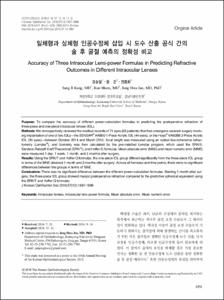일체형과 삼체형 인공수정체 삽입시 도수 산출 공식 간의 술 후 굴절 예측의 정확성 비교
- Keimyung Author(s)
- Jun, Jong Hwa
- Department
- Dept. of Ophthalmology (안과학)
- Journal Title
- 대한안과학회지
- Issued Date
- 2016
- Volume
- 57
- Issue
- 12
- Abstract
- Purpose: To compare the accuracy of different power-calculation formulas in predicting the postoperative refraction of
three-piece and one-piece intraocular lenses (IOL).
Methods: We retrospectively reviewed the medical records of 74 eyes (62 patients) that had undergone cataract surgery involving
implantation of one of two IOLs―the SENSAR® AAB00 1-Piece Acrylic IOL (44 eyes), or the Hoya® VA60BB 3-Piece Acrylic
IOL (30 eyes)―between October 2014 and March 2015. Axial length was measured using an optical low-coherence refractometry
(Lenstar®), and biometry was then calculated by the pre-installed Lenstar program, which used the SRK/II,
Sanders-Retzlaff-Kraff/Theoretical (SRK/T), and Hoffer Q formulas. Mean absolute error (MAE) and mean numeric error (MNE)
were measured 1 day, 1 week, 1 month, and 2 months after surgery.
Results: Using the SRK/T and Hoffer Q formulas, the one-piece IOL group differed significantly from the three-piece IOL group
in terms of the MNE obtained 1 month and 2 months after surgery. Across all formulas and time points, there were no significant
differences between the groups in terms of MAE.
Conclusions: There was no significant difference between the different power-calculation formulas. Starting 1 month after surgery,
the three-piece IOL group showed myopic postoperative refraction compared to the predictive spherical equivalent using
the SRK/T and Hoffer Q formulas.
- Alternative Title
- Accuracy of Three Intraocular Lens-power Formulas in Predicting Refractive Outcomes in Different Intraocular Lenses
- Keimyung Author(s)(Kor)
- 전종화
- Publisher
- School of Medicine
- Citation
- 강승일 et al. (2016). 일체형과 삼체형 인공수정체 삽입시 도수 산출 공식 간의 술 후 굴절 예측의 정확성 비교. 대한안과학회지, 57(12), 1891–1896. doi: 10.3341/jkos.2016.57.12.1891
- Type
- Article
- ISSN
- 0378-6471
- Appears in Collections:
- 1. School of Medicine (의과대학) > Dept. of Ophthalmology (안과학)
- 파일 목록
-
-
Download
 oak-2017-0475.pdf
기타 데이터 / 453.03 kB / Adobe PDF
oak-2017-0475.pdf
기타 데이터 / 453.03 kB / Adobe PDF
-
Items in Repository are protected by copyright, with all rights reserved, unless otherwise indicated.